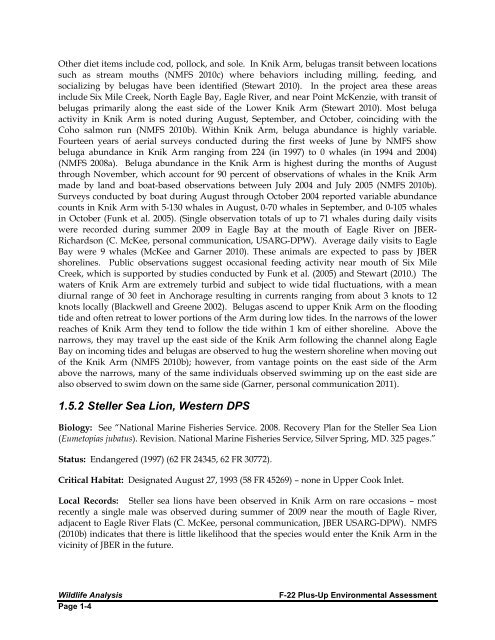F-22 Plus-Up Environmental Assessment - Joint Base Elmendorf ...
F-22 Plus-Up Environmental Assessment - Joint Base Elmendorf ...
F-22 Plus-Up Environmental Assessment - Joint Base Elmendorf ...
You also want an ePaper? Increase the reach of your titles
YUMPU automatically turns print PDFs into web optimized ePapers that Google loves.
Other diet items include cod, pollock, and sole. In Knik Arm, belugas transit between locations<br />
such as stream mouths (NMFS 2010c) where behaviors including milling, feeding, and<br />
socializing by belugas have been identified (Stewart 2010). In the project area these areas<br />
include Six Mile Creek, North Eagle Bay, Eagle River, and near Point McKenzie, with transit of<br />
belugas primarily along the east side of the Lower Knik Arm (Stewart 2010). Most beluga<br />
activity in Knik Arm is noted during August, September, and October, coinciding with the<br />
Coho salmon run (NMFS 2010b). Within Knik Arm, beluga abundance is highly variable.<br />
Fourteen years of aerial surveys conducted during the first weeks of June by NMFS show<br />
beluga abundance in Knik Arm ranging from <strong>22</strong>4 (in 1997) to 0 whales (in 1994 and 2004)<br />
(NMFS 2008a). Beluga abundance in the Knik Arm is highest during the months of August<br />
through November, which account for 90 percent of observations of whales in the Knik Arm<br />
made by land and boat-based observations between July 2004 and July 2005 (NMFS 2010b).<br />
Surveys conducted by boat during August through October 2004 reported variable abundance<br />
counts in Knik Arm with 5-130 whales in August, 0-70 whales in September, and 0-105 whales<br />
in October (Funk et al. 2005). (Single observation totals of up to 71 whales during daily visits<br />
were recorded during summer 2009 in Eagle Bay at the mouth of Eagle River on JBER-<br />
Richardson (C. McKee, personal communication, USARG-DPW). Average daily visits to Eagle<br />
Bay were 9 whales (McKee and Garner 2010). These animals are expected to pass by JBER<br />
shorelines. Public observations suggest occasional feeding activity near mouth of Six Mile<br />
Creek, which is supported by studies conducted by Funk et al. (2005) and Stewart (2010.) The<br />
waters of Knik Arm are extremely turbid and subject to wide tidal fluctuations, with a mean<br />
diurnal range of 30 feet in Anchorage resulting in currents ranging from about 3 knots to 12<br />
knots locally (Blackwell and Greene 2002). Belugas ascend to upper Knik Arm on the flooding<br />
tide and often retreat to lower portions of the Arm during low tides. In the narrows of the lower<br />
reaches of Knik Arm they tend to follow the tide within 1 km of either shoreline. Above the<br />
narrows, they may travel up the east side of the Knik Arm following the channel along Eagle<br />
Bay on incoming tides and belugas are observed to hug the western shoreline when moving out<br />
of the Knik Arm (NMFS 2010b); however, from vantage points on the east side of the Arm<br />
above the narrows, many of the same individuals observed swimming up on the east side are<br />
also observed to swim down on the same side (Garner, personal communication 2011).<br />
1.5.2 Steller Sea Lion, Western DPS<br />
Biology: See “National Marine Fisheries Service. 2008. Recovery Plan for the Steller Sea Lion<br />
(Eumetopias jubatus). Revision. National Marine Fisheries Service, Silver Spring, MD. 325 pages.”<br />
Status: Endangered (1997) (62 FR 24345, 62 FR 30772).<br />
Critical Habitat: Designated August 27, 1993 (58 FR 45269) – none in <strong>Up</strong>per Cook Inlet.<br />
Local Records: Steller sea lions have been observed in Knik Arm on rare occasions – most<br />
recently a single male was observed during summer of 2009 near the mouth of Eagle River,<br />
adjacent to Eagle River Flats (C. McKee, personal communication, JBER USARG-DPW). NMFS<br />
(2010b) indicates that there is little likelihood that the species would enter the Knik Arm in the<br />
vicinity of JBER in the future.<br />
Wildlife Analysis<br />
Page 1-4<br />
F-<strong>22</strong> <strong>Plus</strong>-<strong>Up</strong> <strong>Environmental</strong> <strong>Assessment</strong>
















